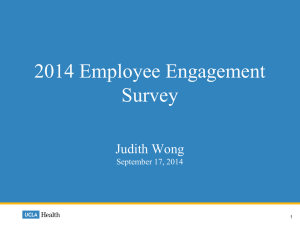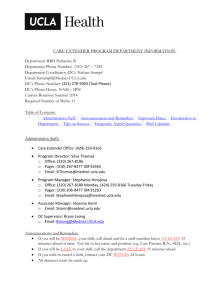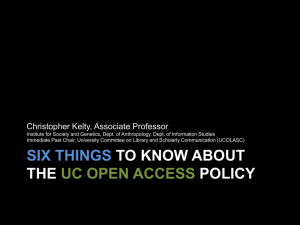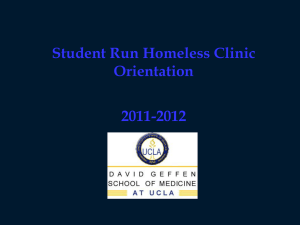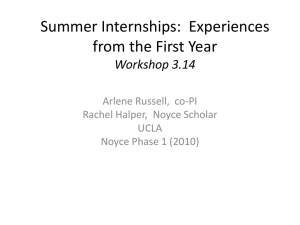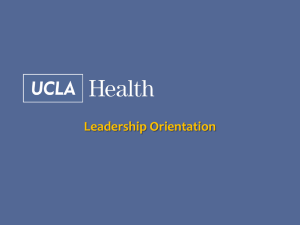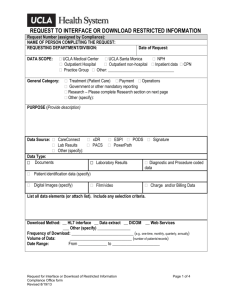Injury Prevention, Ergonomics, Fire & Life Safety
advertisement
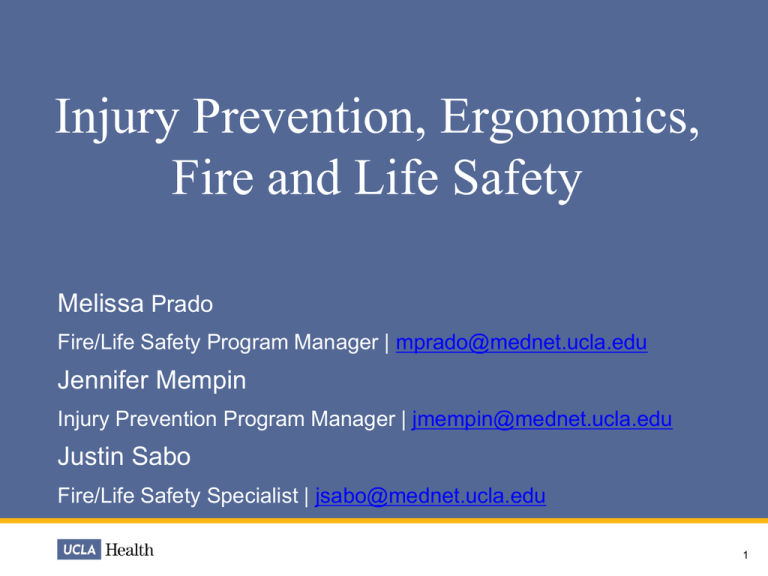
Injury Prevention, Ergonomics, Fire and Life Safety Melissa Prado Fire/Life Safety Program Manager | mprado@mednet.ucla.edu Jennifer Mempin Injury Prevention Program Manager | jmempin@mednet.ucla.edu Justin Sabo Fire/Life Safety Specialist | jsabo@mednet.ucla.edu 1 Fire & Life Safety Fire Safety is a component of the Joint Commission Environment of Care (EC) standards The goal of the Environment of Care (EC) and the Life Safety Programs is to provide a safe, functional and effective environment for patients, staff and visitors Today’s objective: to familiarize yourself with the areas in which you work and be prepared to react to a fire or life safety emergency 2 Fire & Life Safety • Familiarize yourself with your location… • know the location of closest exits • nearest fire extinguishers • nearest fire alarm pull station • know your emergency exit routes and assembly location 3 Fire & Life Safety • Familiarize yourself with fire alarm and emergency response protocols for your area: • Hospital Areas: Defend-in-Place -Close doors to egress corridor and remove any items from corridor -Adjacent units respond to the Code Red location with a fire extinguisher • Ambulatory Areas: Evacuate affected floors (audible/visual signals activated on floors) -Check un-occupied areas while evacuating -Stairwells are safe refuge areas (wheelchair patients) 4 Fire & Life Safety • In the event of a building evacuation always remember to… • Only use STAIRS in an evacuation (never an elevator) • Keep building entrance clear at all times • Evacuate to assembly area (e.g. if in 200MP, assembly area is east of 300MP to sidewalk) • • Fire Drills • Annually • Quarterly at a minimum for non-hospital based/licensed areas for hospital based/licensed areas – (treated as real events) • Egress routes to be kept clear • Don’t • No block entrances or exits chairs or other obstacles left out in the main hallway • Don’t prop doors open (only egress doors with magnets can remain open) 5 Fire and Life Safety • Alarm Pull stations – vary by building • Know where they are located • Fire Alarms – vary by building (audible, visual) • Obey them! • Smoke Detectors – vary by building • Maintain minimum 18” clearance • Sprinklers – vary by building • Maintain minimum 18” clearance in a room with a sprinkler • If no sprinklers: Maintain minimum 24” clearance from ceiling 6 Fire and Life Safety • If you discover a fire… R.A.C.E. Rescue/Remove yourself and others from danger Activate the alarm; pull alarm box and dial 911 (#36 if applicable) Contain the fire; close doors and windows Extinguish if safe to do; OR Evacuate 7 Fire and Life Safety • Types of Fire Classes you may encounter: A, B, C Class A: Ordinary combustibles such as wood, cloth and paper Class B: Flammable liquids such as gasoline and alcohols C: Energized electrical equipment – including wiring fuse boxes, circuit breakers and appliances Class 8 Fire and Life Safety • Types of Fire Extinguishers: ABC, A, BC, K ABC K • When you use a fire extinguisher… P.A.S.S. Pull the pin out Aim the nozzle Squeeze the trigger Sweeping motions from side to side (slowly) at the base of the fire 9 Injury and Illness Prevention Program (IIPP) The intent of the Safety Management and Injury and Illness Prevention Plan is to provide an environment that prevents injuries or illness from occurring within the hospitals and associated structures. 10 General Safety Safety is Everyone’s Responsibility Follow all safety rules and be aware of the environment Report safety hazards to supervisor and Safety Department Annual and routine training/education Safety Liaisons Safety Rounds (Environmental, Support Services, Leadership) Be Smart About Safety! 11 Safety Liaisons The purpose of the UCLA Health System Departmental Safety Liaison Program is to establish an employee driven program that helps to ensure a proactive approach focusing on the safety and wellbeing of all UCLA Health System patients, staff, and volunteers through the promotion of safe work practices and environmental controls. Responsibilities: • • • • • • Support a “culture of safety” within the UCLA Health System. Be an employee volunteer to act as safety champion on their unit. Participate in UCLA Health System Safety Liaison meetings as scheduled. Address & correct immediate minor safety issues. Present the Safety Messages to other staff during huddles and staff meetings. Promote safety initiatives throughout the department and disseminate safety materials to other employees. • Take responsibility for identifying safety issues and reporting them through the appropriate channels. 12 Workplace Injuries Reporting Requirements Overview • INJURY PREVENTION • First goal is to prevent all injuries for occurring Keep pathways clear of obstructions Allow floors to dry before walking Be aware of your surroundings (look up, side to side and down) Pay attention to and adhere to safety signage Report broken equipment immediately to your supervisor (carts, booms, chairs, etc.) Report facility hazards immediately to supervisor and to Health System Facilities (doors, walls, fixtures, outlets, etc.) Use proper body mechanics at all times (standing, sitting, lifting, etc.) 13 Injury Reporting • When an employee is injured on the job . . . Address any immediate injuries (basic first aid) Immediately notify Supervisor/Charge Nurse/Lead The injured employee will be referred to Occupational Health Facility (OHF) or UCLA Emergency Department (ED) for TREATMENT (1) A EMPLOYEE’S CLAIM FORM FOR WORKERS’ COMPENSATION BENEFITS will be completed by the employee and/or supervisor The form must be provided within 24 hours of receipt of notice that an injury or illness has occurred as mandated by California State law. (exception: First Aid incidents) 14 Injury Reporting (2) A EMPLOYEE’S REFERRAL SLIP FOR INDUSTRIAL INJURY AND REPORT OF ACCIDENT will be filled out by the supervisor Complete an Event Report via the Event Reporting System Health System Human Resources Workers’ Compensation will be contacted by OHF or ED If the injured employee is taken off work, the Personnel/Payroll representative will be contacted to begin appropriate payroll process 15 Serious Injuries Any serious injury to an employee that occurs while at work must be reported immediately to the Supervisor/Charge Nurse/Lead. These are injuries are required to be reported to the State within 8 hours of the injury. • Serious Injuries list: Amputation Concussion Crushing Fractures Lacerations requiring stitches or with significant bleeding Any employee admitted to the hospital for greater than 24 hours 16 Serious Injury Poster 17 What is Ergonomics? • Science of fitting the workplace, furniture, tasks, tools and equipment to the worker. • Ergonomics (or human factors) is the scientific discipline concerned with the understanding of interactions among humans and other elements of a system, and the profession that applies theory, principles, data and methods to design in order to optimize human well-being and overall system performance. (International Ergonomics Association) 18 Resources • BruinErgo - Online ergonomic training and assessment program • Safety Department – Available for onsite consultation via Support Services website • NIOSH (National Institute for Occupational Safety and Health): Ergonomics and Musculoskeletal Disorders http://www.cdc.gov/niosh/topics/ergonomics/ • UCLA Ergonomics – Provides injury prevention, ergonomics and wellness education and information www.ergonomics.ucla.edu 19 Safety Department • Erik Eggins Director | eeggins@mednet.ucla.edu | Pager ID: 90248 • Elizabeth Genta Assistant Director | egenta@mednet.ucla.edu | Pager ID: 99103 • Melissa Prado Fire/Life Safety Program Manager| mprado@mednet.ucla.edu | Pager ID: 99218 • Jennifer Mempin Injury Prevention Program Manager| jmempin@mednet.ucla.edu | Pager ID: 99828 • Justin Sabo Fire/Life Safety Specialist | jsabo@mednet.ucla.edu | Pager ID: 97705 20 Questions? Keeping Safe! 21
